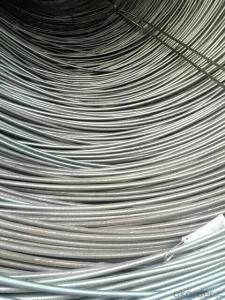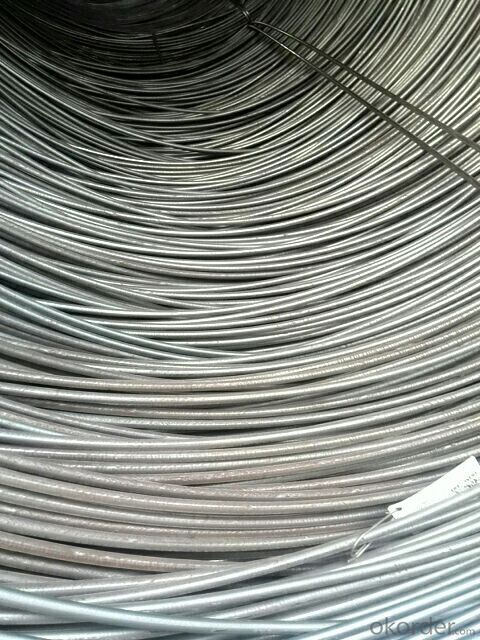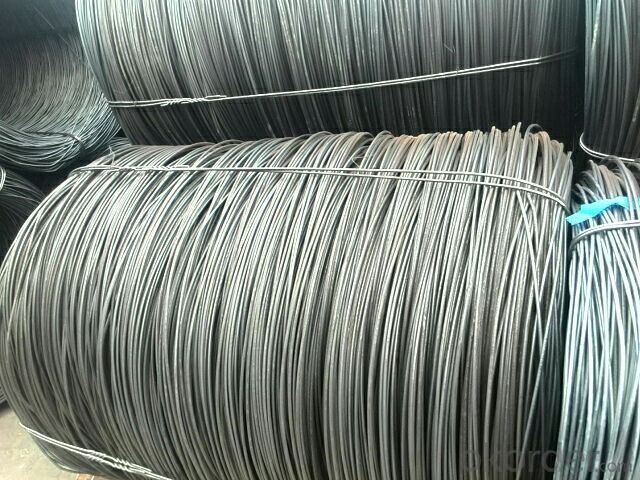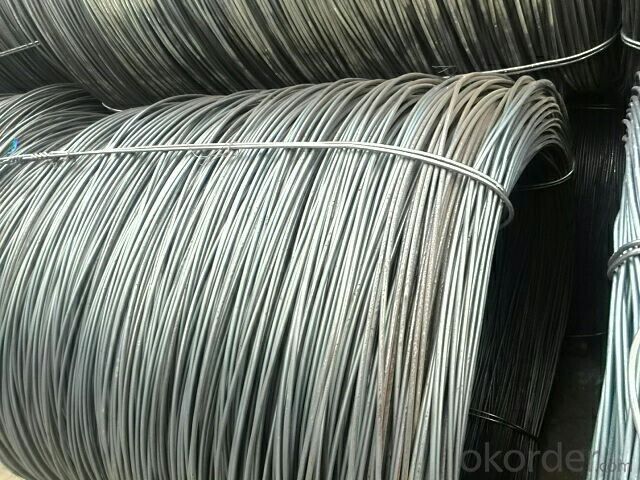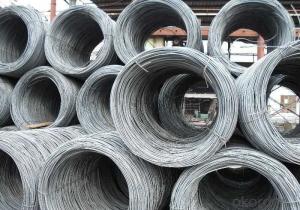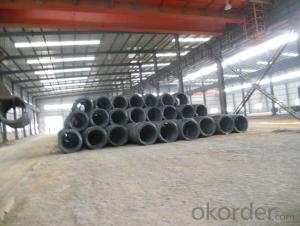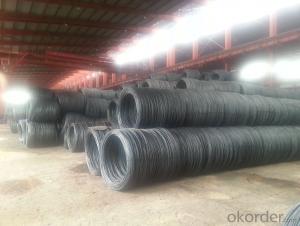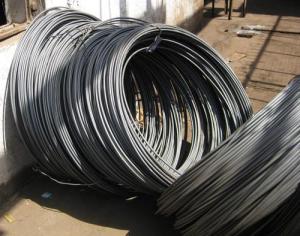Hot Rolled Wire Rod Sae1006-1018B
- Loading Port:
- China Main Port
- Payment Terms:
- TT or LC
- Min Order Qty:
- -
- Supply Capability:
- -
OKorder Service Pledge
OKorder Financial Service
You Might Also Like
Product Description:
OKorder is offering Hot Rolled Wire Rod SAE1006-1018B
at great prices with worldwide shipping. Our supplier is a world-class manufacturer of steel, with our products utilized the world over. OKorder annually supplies products to European, North American and Asian markets. We provide quotations within 24 hours of receiving an inquiry and guarantee competitive prices.
Hot Rolled Wire Rod SAE1006-1018B are ideal for structural applications and are widely used in the construction of buildings and bridges, and the manufacturing, petrochemical, and transportation industries.
Product Advantages:
OKorder's Hot Rolled Wire Rod SAE1006-1018B durable, strong, and resist corrosion.
Main Product Features:
· Premium quality
· Prompt delivery & seaworthy packing (30 days after receiving deposit)
· Corrosion resistance
· Can be recycled and reused
· Mill test certification
· Professional Service
· Competitive pricing
Product Specifications:
Steel Grade: Q195/235, SAE1006-1018B Standard: ASTM, GB
Diameter: 5.5mm, 6.5mm, 7mm,8mm,9mm,10mm,12mm,14mm
Type: in coil, coil weight around 2MT Alloy or Not: Alloy
Technique: Hot Rolled Place of Origin: China Mainland
Surface: round, no twisted, light and smooth Brand Name: HSKY
Chemical Composition: (Please kindly find our chemistry of our material based on Q195、Q235A and Q235B as below for your information)
Trademark | Rank | Chemical composition (quality score) % | |||||||
C | Si | Mn | S | P | |||||
| ≤ |
| ≤ | ≤ | |||||
Q195 |
| 0.06-0.12 | 0.30 | 0.25 | 0.050 | 0.045 | |||
Q235 | A | 0.14-0.22 | 0.30 | 0.30-0.65 | 0.050 | 0.045 | |||
Q235 | B | 0.12-0.20 | 0.30 | 0.30-0.70 | 0.045 | 0.045 | |||
Packaging & Delivery of Hot Rolled Wire Rod:
Packaging Detail: products are packed in coil, each coil weight around 2 MT, and then shipped by container or bulk vessel
FAQ:
Q1: Why buy Materials & Equipment from OKorder.com?
A1: All products offered byOKorder.com are carefully selected from China's most reliable manufacturing enterprises. Through its ISO certifications, OKorder.com adheres to the highest standards and a commitment to supply chain safety and customer satisfaction.
Q2: How do we guarantee the quality of our products?
A2: We have established an advanced quality management system which conducts strict quality tests at every step, from raw materials to the final product. At the same time, we provide extensive follow-up service assurances as required.
Q3: Can stainless steel rust?
A3: Stainless does not "rust" as you think of regular steel rusting with a red oxide on the surface that flakes off. If you see red rust it is probably due to some iron particles that have contaminated the surface of the stainless steel and it is these iron particles that are rusting. Look at the source of the rusting and see if you can remove it from the surface.
Images:
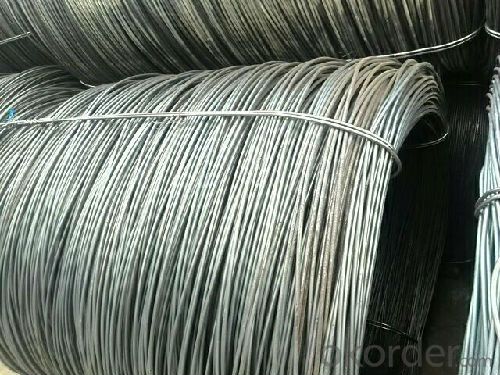
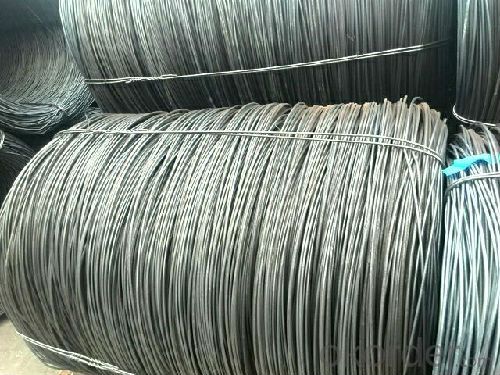
- Q: What are the main factors influencing the choice of steel wire rod packaging?
- The main factors influencing the choice of steel wire rod packaging include the requirements for protection, transportation, handling, and storage of the product. One of the key factors is the need for protection. Steel wire rods are prone to damage from various external factors such as moisture, dirt, and corrosion. Therefore, the packaging must provide adequate protection against these elements to ensure the quality and integrity of the product. This may involve using materials that are moisture-resistant, such as plastic or coated paper, and implementing measures to prevent rust and corrosion, such as applying anti-corrosion coatings. Transportation considerations also play a crucial role in determining the packaging choice. Steel wire rods are often transported over long distances, either by road, rail, or sea. The packaging should be sturdy enough to withstand the rigors of transportation, including potential impacts and vibrations. It should also be designed in a way that facilitates easy loading and unloading, and minimizes the risk of damage during handling and transportation. The storage requirements of steel wire rods also influence the packaging choice. Depending on the storage conditions, such as indoor or outdoor storage, the packaging may need to offer additional protection against factors like sunlight, extreme temperatures, and humidity. It should also be stackable to optimize space utilization and prevent any deformation or bending of the wire rods. Other factors that may influence the choice of steel wire rod packaging include cost-effectiveness, sustainability, and regulatory compliance. Companies may consider the cost of the packaging material, its availability, and the overall packaging process to ensure that it aligns with their budget and operational efficiency. Moreover, there is an increasing focus on sustainable packaging solutions that minimize environmental impact, such as using recyclable materials or reducing the overall packaging waste. Compliance with industry standards and regulations, such as safety and labeling requirements, is also a significant consideration in the choice of steel wire rod packaging.
- Q: How is the grain size of steel wire rod measured?
- Metallography, a method commonly employed for measuring the grain size of steel wire rod, involves a series of steps. Initially, a small piece of the rod is cut, and subsequently, it is subjected to grinding and polishing to procure a smooth surface. Once the surface is adequately prepared, a chemical reagent is employed to etch the sample, thereby unveiling the grain boundaries. This etching process facilitates the differentiation of individual grains and enhances their visibility when observed through a microscope. Following the etching process, the sample is meticulously examined under a high magnification microscope. During this examination, the grains are meticulously counted, and their size is determined using either a measuring reticle or specialized software. Consequently, the grain size is typically reported as either an average grain diameter or a grain size number, representing the number of grains within a given area. It is crucial to acknowledge that the measurement of grain size is subject to subjectivity and may vary according to the observer's interpretation. Therefore, standardized methodologies such as ASTM E112 or ISO 643 are commonly employed to ensure uniformity and precision in grain size measurements. These standards offer comprehensive guidelines regarding sample preparation, etching techniques, and grain size determination.
- Q: How are steel wire rods used in the production of wire ropes for ships?
- Steel wire rods are used as the primary material in the production of wire ropes for ships. These rods are first drawn into wire strands, which are then twisted together to form a strong and durable rope. The wire ropes are essential for various applications on ships, such as lifting heavy loads, mooring, and anchoring. Their strength and flexibility make them ideal for withstanding the harsh conditions at sea and ensuring the safe and efficient operation of ships.
- Q: How is steel wire rod used in the oil and gas industry?
- Steel wire rod is used in the oil and gas industry for various applications such as reinforcing concrete structures, manufacturing drilling equipment, and constructing oil rigs. It is commonly used as a strong and durable material that can withstand high pressures and temperatures in the extraction and transportation of oil and gas.
- Q: How are steel wire rods used in the manufacturing of wire ropes?
- Wire ropes are manufactured using steel wire rods, which are an essential component in the process. These rods serve as the raw material from which individual wires are produced and then twisted together to form the rope. To begin the manufacturing process, the steel wire rods are drawn through a series of dies. This draws out the rods, reducing their diameter and increasing their length. This step, called wire drawing, results in wires of different sizes and strengths. Once the desired wires are obtained, they are twisted together in a specific pattern to create strands. These strands are typically helically twisted around a core, which can be another wire or a fiber material. The number of strands and the direction of the twist are determined by the intended use and load requirements of the wire rope. The selection of steel wire rods is crucial for their high tensile strength, durability, and resistance to corrosion. Steel is known for its excellent strength-to-weight ratio, making it ideal for applications that require reliable and robust wire ropes. Furthermore, the quality of the steel wire rods is vital for the performance and longevity of the wire rope. The steel must meet strict specifications to ensure it can withstand heavy loads, extreme weather conditions, and repetitive stress without compromising the integrity of the wire rope. In conclusion, the manufacturing process of wire ropes involves transforming steel wire rods into wires through wire drawing. These wire ropes are widely used in industries such as construction, mining, maritime, and transportation, where they are valued for their strength, durability, and ability to withstand demanding conditions.
- Q: What are the standard tensile strength requirements for steel wire rod?
- The standard tensile strength requirements for steel wire rod vary depending on the specific grade and application. However, commonly used steel wire rods typically have a tensile strength range of 400 to 1000 megapascals (MPa).
- Q: How does the fatigue strength of steel wire rod vary with different diameters?
- Steel wire rod fatigue strength typically varies depending on its diameter. Generally, an increase in diameter leads to a decrease in fatigue strength. This occurs because larger diameter rods have a greater likelihood of containing defects or imperfections, such as inclusions or microstructural irregularities. These flaws act as stress concentrators, reducing the fatigue strength. Furthermore, larger diameter rods have a larger surface area, increasing the chances of surface defects or corrosion. These factors can negatively impact the fatigue strength. Additionally, larger diameter rods have lower bending stiffness, resulting in higher stresses and strains under cyclic loading, further reducing fatigue strength. Conversely, smaller diameter steel wire rods tend to have higher fatigue strength due to their reduced surface area and fewer chances of defects. Smaller diameter rods also have higher bending stiffness, which helps distribute the applied load more evenly, reducing localized stress concentrations and improving fatigue strength. However, it is important to note that other factors can influence the fatigue strength of steel wire rods, such as the specific type and quality of the steel, the manufacturing process, and the surface treatment. Therefore, when evaluating fatigue strength, it is necessary to consider these factors in addition to the diameter.
- Q: How is steel wire rod used in the manufacturing of wire forms for power lines?
- Steel wire rod is an essential component in the manufacturing of wire forms for power lines due to its strength, durability, and conductivity. The wire rod is first processed through a series of manufacturing steps to transform it into wire forms suitable for power transmission purposes. To begin with, the steel wire rod is typically hot-rolled to achieve the desired diameter and shape. This process involves passing the rod through a series of rollers that apply pressure and heat, resulting in a long, continuous wire. The hot-rolled wire is then cooled to increase its strength and hardness. Next, the wire is usually subjected to a drawing process. This involves pulling the wire through a series of dies with progressively smaller openings, which reduces its diameter and increases its tensile strength. This step also helps to improve the wire's surface finish and overall quality. After the wire is drawn to the desired size, it undergoes various treatments to enhance its mechanical properties. These treatments may include annealing, where the wire is heated and slowly cooled to relieve internal stresses and improve ductility. The wire may also be galvanized or coated with a protective layer to enhance its corrosion resistance. Once the wire is properly processed and treated, it can be transformed into various wire forms used in power line applications. For example, the wire may be coiled to create transmission lines that carry electricity over long distances. It can also be formed into overhead conductors or ground wires that are suspended on power line towers to transmit electrical energy. In addition to its strength and durability, steel wire rod offers excellent electrical conductivity, making it an ideal material for power line applications. The high conductivity allows for efficient transmission of electricity across the wire forms, minimizing energy losses during transmission. Overall, steel wire rod plays a crucial role in the manufacturing of wire forms for power lines by providing the necessary strength, durability, and conductivity required for efficient and reliable power transmission.
- Q: How does the cost of steel wire rod compare to other materials?
- The cost of steel wire rod generally tends to be lower compared to other materials commonly used for similar applications. Steel wire rod is widely available and produced in large quantities, which helps to keep the price relatively low. Additionally, steel is a highly recyclable material, which further contributes to its cost-effectiveness. In comparison to alternative materials such as aluminum or copper wire rod, steel wire rod is typically more affordable. However, it is important to consider that the cost of steel wire rod can vary depending on factors such as market demand, quality, and specific application requirements.
- Q: What are the different surface lubricants used for steel wire rod?
- There are several different surface lubricants that are commonly used for steel wire rod. These lubricants are applied to the surface of the wire rod to reduce friction and improve the drawing process. One commonly used lubricant is a water-based emulsion. This type of lubricant contains a mixture of water and oil, along with additives to enhance its lubricating properties. Water-based emulsions are often used for drawing operations that require high-speed and high efficiency. Another type of lubricant used for steel wire rod is a dry lubricant. Dry lubricants are typically powder-based and are applied to the surface of the wire rod in dry form. These lubricants can provide excellent lubrication properties while minimizing the potential for contamination or mess. Some steel wire rod manufacturers also use oil-based lubricants. These lubricants are typically petroleum-based and can provide good lubrication properties for a wide range of drawing operations. However, oil-based lubricants may require additional cleaning steps to remove any residual oil from the wire rod surface. In addition to these commonly used lubricants, there are also specialty lubricants available for specific applications. For example, some wire rod manufacturers may use graphite-based lubricants for drawing operations that require high temperatures or extreme pressures. Overall, the choice of surface lubricant for steel wire rod will depend on factors such as the specific drawing operation, the desired level of lubrication, and any specific requirements or restrictions for the end product.
Send your message to us
Hot Rolled Wire Rod Sae1006-1018B
- Loading Port:
- China Main Port
- Payment Terms:
- TT or LC
- Min Order Qty:
- -
- Supply Capability:
- -
OKorder Service Pledge
OKorder Financial Service
Similar products
Hot products
Hot Searches
Related keywords
